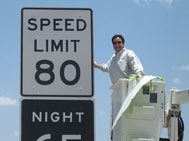10/26/2009
Utah DOT: No Downside to 80 MPH Speed Limit IncreaseSpeed limit increase to 80 MPH on Interstate 15 in Utah results in no change in highway fatalities.

The Utah Department of Transportation (UDOT) announced last week that the experimental increase in the state's maximum speed limit to 80 MPH has been a success in terms of safety. UDOT Deputy Director Carlos Braceras testified before the state Interim Committee on Transportation that that there has been no increase in accidents as a result of the higher number printed on the speed limit signs on certain stretches of Interstate 15.
In 2008, the state legislature granted UDOT permission to test higher limits on rural sections of the road. Using crash histories, engineering studies, UDOT carefully selected the areas that it believed would best handle the increased limit. The department then conducted before and after surveys of speeds and traffic volume on the three sections where the limit was changed. Although the signs permitted another 5 MPH in speed, the results showed that drivers did not 'take advantage' of the new limit to drive significantly faster.
"Overall we saw speeds increase between two and three miles per hour," Braceras explained. "The speed differentials did increase... We saw no change in accident history, which with how careful we were in choosing this location it wasn't surprising to us, but it was very good news to see that... The number of vehicles exceeding the speed limit decreased 20 percent."
With the speed limit posted at 75 MPH, 85th percentile speeds measured between 81 and 85 MPH -- barely different from the 83 to 85 MPH speeds under the higher 80 MPH limit. The 85th percentile speed represents the speed at which 85 percent of free-flowing traffic feels is the safest. Engineers have determined that the greatest safety can be achieved when speed limits match the 85th percentile speed. State Representative James Dunnigan (R-Taylorsville) championed the results as evidence that the law allowing a higher limit has been a success.
"One of the concerns when we presented this bill a couple of sessions ago was that people would increase speeds to 90 or 95 and there would be tremendous carnage on the road," Dunnigan said. "So even though it has only been a year, that has not happened. And really all that's happened is that people haven't changed their speed much -- a little bit -- but they're doing so legally... So by increasing the speed limit to 80, we just made them legal."
National Motorists Association researcher John Carr reviewed the data and suggested that coverage of speed limit increases always includes dire predictions of increased carnage. He pointed to an accident on the 75 MPH portion of I-15 just after the limit was raised on a nearby stretch as an example of skewed perspectives on the issue.
"It could have been anywhere," Carr wrote. "Inside the 80 MPH zone it would have been taken as proof that the speed limit increase was recklessly endangering drivers. In the 75 zone it was not taken as an indictment of the low speed limit. That is how people think about speed limits. Ignore what they don't want to believe, panic over what they do want to believe."
UDOT is pleased with the results and will continue to watch the performance of I-15 under the higher limits.
"We believe this warrants further examination in the long term," Braceras said. "We take safety very seriously... This isn't something we consider to be a trivial undertaking -- just go up and change the speed limit sign... We may want to after we've had a chance to evaluate this a little longer and we feel that we have something with more statistical significance it may be appropriate at that time to expand it to other sections of other highways."


